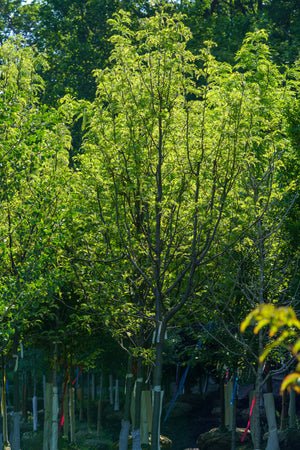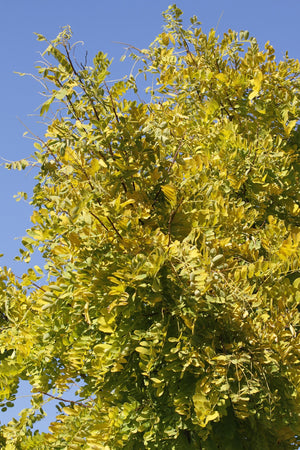The Honeylocust Guide
Honeylocust trees (Gleditsia triacanthos) are fast-growing, deciduous shade trees appreciated for their light, dappled canopy, finely textured foliage, and adaptability to tough urban conditions. With cultivars selected for thornlessness, fruitlessness, and upright form, honeylocust has become a staple in modern street tree and large-scale landscape plantings. Their graceful appearance, filtered light, and manageable leaf drop make them ideal for settings where visual openness and low-maintenance design are priorities.
About
Native to central and eastern North America, Gleditsia triacanthos (honeylocust) was once known for its aggressive thorns and long, twisted seed pods. However, modern cultivars—specifically those of the inermis variety—are bred to be thornless and seedless, making them suitable for a wide range of urban and residential landscapes.
Popular cultivars include:
- 'Shademaster' – Upright, spreading form with a strong central leader and nearly seedless habit.
- 'Skycole' (Skyline) – Denser canopy and strong pyramidal form, also seedless.
- 'Street Keeper' – Narrow, upright form ideal for confined urban spaces.
- 'Impcole' (Imperial) – Rounded crown and compact size, making it suitable for smaller properties.
- 'Christie' – A vigorous variety with a broad, uniform shape.
All of these are varieties of Gleditsia triacanthos f. inermis, meaning they are naturally thornless and preferred for modern landscape use. Their fine, pinnately compound leaves provide dappled shade that allows sunlight to filter through to lawns or understory plantings below—unlike the dense shade cast by maples or oaks. In fall, their foliage turns a bright, cheerful yellow.
Because honeylocust tolerates pollution, salt, compacted soil, and drought once established, it is frequently planted in streetscapes, parking lots, and commercial developments where few other trees thrive.

PLANTING
Proper planting allows honeylocust trees to establish quickly and thrive for decades.
USDA Hardiness Zones: 4–9, depending on cultivar and local conditions.
Soil: Adapts to a wide range of soils including clay, loam, and sandy types. Prefers moist, well-drained soils but is highly tolerant of compaction and alkalinity.
Sunlight: Requires full sun for best growth and canopy development. Trees planted in shaded areas will be thinner and less symmetrical.
Watering: Moderate water needs during establishment. Once mature, honeylocust is drought-tolerant and rarely requires supplemental irrigation except in extreme heat.
Spacing: Space trees 25–35 feet apart depending on cultivar. Narrow forms like ‘Street Keeper’ can be spaced more tightly for allees or street-side plantings.
Planting Time: Best planted in early spring or fall. Winter planting may be possible in milder climates, provided the ground is not frozen and adequate moisture is available.

CARE
Honeylocust trees are low-maintenance once established, but benefit from early pruning and site awareness.
Watering: Water regularly for the first two years after planting. Mature trees tolerate dry periods well, especially in urban conditions.
Fertilizing: Rarely needed unless planted in poor or depleted soil. Apply a slow-release, balanced fertilizer in early spring only if foliage appears sparse or growth is slow.
Pruning: Structural pruning in the first 5–10 years is important to establish a strong central leader and balanced branching. Remove weak, narrow-angle, or crossing branches during dormancy. Once mature, pruning needs are minimal.
Pests & Diseases: Generally pest-resistant, though spider mites, cankers, or mimosa webworm can occasionally be issues in stressed trees. Maintain vigor through proper planting and care to avoid problems.
Mulching: Mulch 2–3 inches deep around the root zone to conserve moisture and prevent mower or string-trimmer damage. Keep mulch away from the trunk flare.
HOW TO USE
Honeylocust trees offer flexible design applications, especially where filtered shade, height, and toughness are needed. Their adaptable growth habits and manageable leaf drop make them particularly useful in contemporary settings.
Focal Point: Use pyramidal cultivars like ‘Skycole’ (Skyline) or upright selections like ‘Street Keeper’ as focal point trees in courtyards, entryways, or small public greens. Their striking architecture and golden fall foliage add seasonal interest and vertical structure.
Urban Shade Trees: Honeylocust excels in commercial sites, plazas, and streetscapes where soil compaction, heat, and salt would challenge most other trees. Cultivars like ‘Shademaster’ and ‘Imperial’ have been extensively planted in cities across North America for this reason.
Parking Lots and Medians: Their high canopy clearance and tolerance of tough growing conditions make honeylocust ideal for parking lot islands and road medians. Their small leaflets break down quickly and require less cleanup than other deciduous species.
Residential Lawns: Homeowners value honeylocust for its filtered shade, which allows grass or shade-tolerant perennials to grow beneath it. ‘Impcole’ (Imperial) and ‘Shademaster’ are ideal for providing coverage over outdoor seating areas or lawn spaces.
Mixed Plantings: Underplant with drought-tolerant grasses and perennials such as prairie dropseed, echinacea, baptisia, or coreopsis to create low-maintenance, naturalistic plantings. In more refined landscapes, pair with boxwood, salvia, or Russian sage for clean contrasts in form and texture.
Campus, Park, and Civic Landscapes: With their longevity and broad canopy, honeylocust trees are excellent for large-scale open lawns, civic grounds, and university campuses, where they provide consistent structure and shade over time.
Reforestation and Open Plantings: Although not native to all regions, honeylocust is occasionally used in open space plantings where fast establishment and drought tolerance are priorities.

Common Questions
Are honeylocust fragrant? Honeylocust flowers are small and not highly fragrant. Their bloom is subtle and typically not noticeable from a distance.
Are Skyline honeylocust messy? No. ‘Skyline’ (Skycole) is a fruitless cultivar, meaning it does not produce seed pods. Its fine leaflets break down quickly in fall, making it one of the cleanest shade trees available.
Can you plant honeylocust trees in the winter? In mild climates, honeylocust can be planted in winter as long as the ground isn’t frozen and proper moisture is maintained. In colder zones, early spring or fall planting is preferred.
Does Shademaster honeylocust produce fruit? ‘Shademaster’ is considered a seedless or nearly seedless cultivar. In rare cases, some pod development may occur, but it is generally minimal.
Does Shademaster honeylocust have thorns? No. Like other inermis forms, ‘Shademaster’ is thornless and safe for use in residential and commercial landscapes.
How big does a honeylocust tree grow? Most cultivars mature at 40 to 50 feet tall and 30 to 40 feet wide. Dwarf and columnar cultivars may stay smaller, while species-type trees can exceed 70 feet under optimal conditions.
How fast do honeylocust trees grow? Honeylocust trees are fast-growing, often gaining 1.5 to 2.5 feet per year during early development. Growth slows slightly with age but remains steady.
Is honeylocust shallow rooted? Honeylocust trees have an extensive but shallow root system that spreads horizontally. While not as surface-oriented as silver maple, roots may rise to the surface in compacted or dry soils over time.
Conclusion
Honeylocust is a rugged, elegant, and low-maintenance shade tree perfect for modern landscapes. Its filtered canopy, fast growth, and urban toughness make it an ideal choice for parks, streets, parking areas, and home lawns alike. With fruitless, thornless cultivars like ‘Shademaster’, ‘Skyline’, and ‘Street Keeper’, today’s honeylocust offers beauty without the mess—and a reliable structure that enhances both functional and aesthetic goals in nearly any setting.
The Honeylocust Collection
Sold Out
Sold Out




